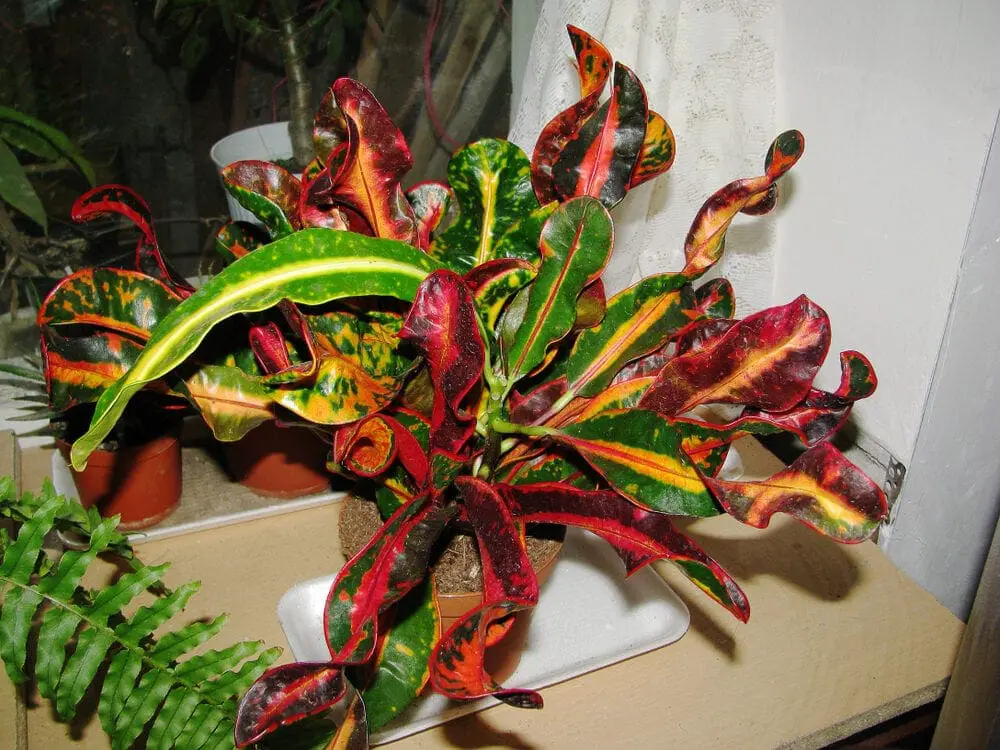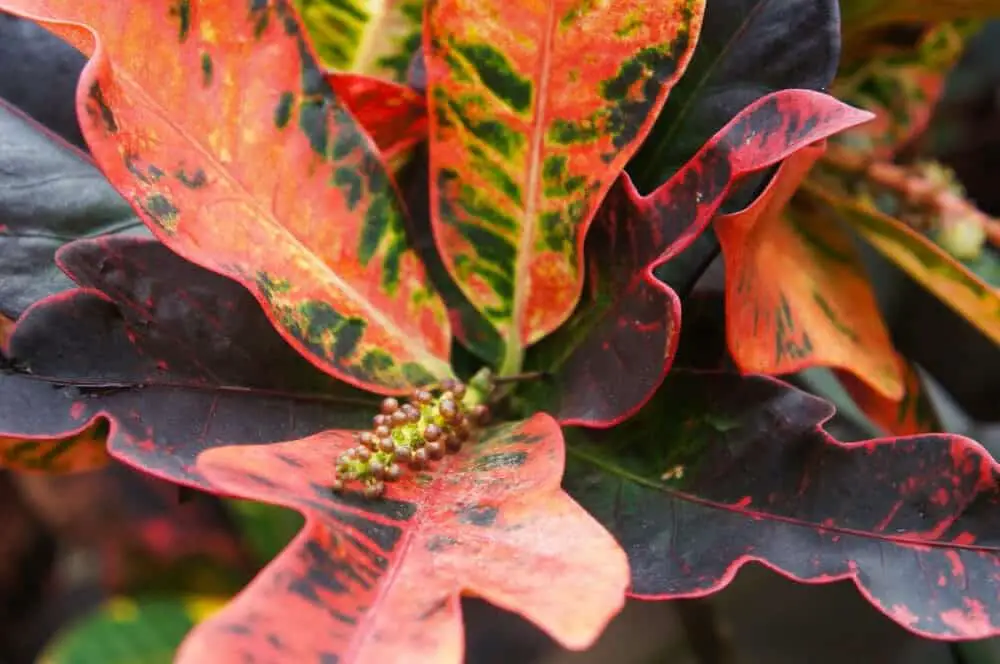Crotons are popular house plants due to their brightly colored leaves. They’re relatively easy to care for, but there are a few things you need to know in order to keep them happy and healthy.
In this guide, we’ll provide you with everything you need to know about growing crotons, from potting them in the right type of soil to keeping them well-watered. So if you’re thinking of adding a croton plant to your home décor, read on!
What is a Croton Mammy plant?
The Croton Mammy (Codiaeum variegatum) is a type of plant that has colorful leaves and twists as it grows. It’s also known by several other names, such as Codiaeum Mammy or if you prefer – “Mammy croots.”
Croton Mammy plants love heat and moisture in the air. Its leaves are often different colors like red, green, yellow, and orange, which liven up any home or garden.
The Croton Mammy is a beautiful plant that can be found all over the world nowadays. Its origins are native to Malaysia, Indonesia, and Australia but it has since morphed into an indoor as well outdoor decorative shrub due to its popularity
Other Common Names:
- Mamey Croton
- Mammy Croton
- Croton Mamey
- Codiaeum variegatum
Croton Mammy Care and Growing Guide
1. Light requirements
Since Croton plants originated in the tropics, they need full sun to grow healthy and strong. The color of the leaves will reflect the amount of sun that it is receiving. They must be directly under the sunlight.
But they can be under a window that receives full sun for several hours of the day. If you live in a hot area, though, you will have to cover the plant during the hottest part of the day.
2. Water
There must be enough water to make the ground moist but overwatering the plant when it is growing in the spring months will stop its growth. The soil must drain quickly, and water cannot stay around the roots.
Because it is a tropical plant, there must be humidity in the air as well. The drier the air is, the more it must be watered.
3. Climate
The best type of climate needed for the Croton Mammy plant to grow and thrive is in tropical weather. This plant loves humidity and hot air and sunlight.
A greenhouse is an excellent way for croton plants to have stable tropical weather all year round.
4. Soil
Croton Mammy plants need to be in soil that drails very well. But these plants are grown in any kind of soil, acidic, alkaline, and basic. Water cannot collect and stay around the roots. This goes for both potted and outdoor plants.
If the soil locks in too much moisture around the roots, the roots will start to rot, and the plant will die.

5. Temperature
The Croton Mammy is a tropical plant, so it’s not built to stand extreme hot or cold weather. Anything temperature below 55 degrees can damage the plant’s leaves and cause them to brown and wither.
And if the temperature goes above 80 degrees, the Croton will not grow as strong as the humidity will be suffocating.
6. Repotting
When your Croton plants have grown too large for their current pot, you have to repot in a container that is only slightly larger than the one it’s in now.
If you replant it in a pot that is too large, the roots will grow faster than the plant. The perfect time to repot the plant is in late spring, towards the end of the growing season.
7. Speed of Growth
A typical croton plant does not grow very fast, only at a rate of fewer than 12 inches in the entire growing season.
8. Height and spread
If cared for ideally, the croton mammy plant can grow as tall as ten feet high, although it can be trimmed and stunted if it is indoors. But many other varieties grow up to three feet, which is perfect for the indoors.
The spread of the plant is very wide, around 3 to 6 feet, depending on how lush the leaves are and how old the plant is.
Also read: Purple Waffle Plant Care & Growing guide
9. Flowers
The flowers of the Croton Mammy plant are not much to look at. They’re small and white and fuzzy. When they appear, they will sometimes have small vines that come from under the bulb. Some years the plant will not flower at all, but that is typical for a croton plant.
10. Trimming
Croton plants shouldn’t be trimmed often, as they take longer to grow. Only trim away diseased plant parts or large leaves or stems that could be taking up too much nutrition from the rest of the plant. Don’t cut off more than ⅓ of the height, or you could send the plant into shock.

Is the Croton Mammy plant poisonous?
No, the Croton Mammy plant is not poisonous, and it cannot poison your animals. However, this is not a plant to have around children. If a leaf is pulled off or tears, the sap from inside can get onto a person’s cause and cause severe irritation and even an allergic reaction.
It’s not a plant that you can eat, because it has no edible properties. Eating it will cause some discomfort or nausea because of the irritating sap. It’s not recommended that you eat this plant if you’re starving in the jungle.
More like this: Oxalis Plant Care & Growing Guide
Can Croton Mammy plants grow in water?
Although Croton plants would be a beautiful sight to see when you are swimming inside of a lake or pond, this plant cannot grow in water. It is very easy for the croton to develop root rot, which will infect the roots and kill the plant.
How to get Croton Mammy plants to flower?
The best way to make sure the croton plant flowers is to wait for springtime while keeping the air around the plant humid and warm. If the flowers appear underneath the leaves, they are so small that most people don’t even know they’re there.
Also read:
Common Croton Mammy Plant Diseases
Crown Gall is a common croton disease in which bacteria form stick, swollen growths on the stems of the plants. If croton plants have this disease, it often cannot be cured or treated. You must cut away all infected parts and discard them far away from the Croton. It spreads easily and quickly, so act fast the moment you see crown gall.
Powdery mildew is a common aesthetic disease that happens to most plants that experience moisture and humidity. It is not very harmful to plants; it just makes the leaves look ugly.
But too much of the mildew can keep leaves from developing a healthy shape and structure. It can be treated with neem oil or wiping each leaf with baking soda.
keep reading:
- Moses in the Cradle Plant Care & Growing Guide
- Arrowhead Plant Care & Growing Guide
- Lucky Bamboo: Plant Care and Growing Guide
Conclusion
- The Croton Mammy plant needs to be in warm, humid weather to grow well. It doesn’t like cold or hot extremes.
- When watered, the soil must drain quickly, or else you could risk giving the croton root rot. Keep the grow moisture, but not wet.
- The growing zones for this plant are 9-11 if it is indoor and 4-11 if it outdoors.
- On average, this plant grows to around three feet in height and three to six feet in width
- It needs full sun for several hours of the day, even if it is an indoor plant.
Victoria is the owner and main author of hobby plants. She loves spending her free time in her garden planting and taking care of her plants. Victoria hopes you enjoy the content here!
![Bush On Fire Croton Plant Care: [Complete Beginner's Guide] Bush On Fire Croton Plant Care: [Complete Beginner's Guide]](https://www.hobbyplants.com/wp-content/uploads/2022/09/bush-on-fire-croton-300x158.jpg)
![Mother Of Thousands Plant [Complete Plant Care Guide] Mother Of Thousands Plant [Complete Plant Care Guide]](https://www.hobbyplants.com/wp-content/uploads/2022/07/mother-of-thousands-plant-300x158.jpg)
![Majesty Palm Plant Care: [Complete Beginner's Guide] Majesty Palm Plant Care: [Complete Beginner's Guide]](https://www.hobbyplants.com/wp-content/uploads/2022/08/majesty-palm-care-300x158.jpg)
![Exotic Angel Plant Care: [Complete Beginner's Guide] Exotic Angel Plant Care: [Complete Beginner's Guide]](https://www.hobbyplants.com/wp-content/uploads/2022/08/exotic-angel-plant-care-300x158.jpg)
![Snow White Waffle Plant: [Complete Care Guide] Snow White Waffle Plant: [Complete Care Guide]](https://www.hobbyplants.com/wp-content/uploads/2022/08/snow-white-waffle-plant-300x158.jpg)
![Waffle Plant Care: [Complete Beginner's Guide] Waffle Plant Care: [Complete Beginner's Guide]](https://www.hobbyplants.com/wp-content/uploads/2022/08/waffle-plant-300x158.jpg)
![Bird Of Paradise Plant Care: [Complete Beginner's Guide] Bird Of Paradise Plant Care: [Complete Beginner's Guide]](https://www.hobbyplants.com/wp-content/uploads/2022/08/bird-of-paradise-plant-300x158.jpg)
![Purple Passion Plant Care: [Complete Beginner's Guide] Purple Passion Plant Care: [Complete Beginner's Guide]](https://www.hobbyplants.com/wp-content/uploads/2022/08/purple-passion-plant-care-300x158.jpg)
![China Doll Plant Care: [Complete Beginner's Guide] China Doll Plant Care: [Complete Beginner's Guide]](https://www.hobbyplants.com/wp-content/uploads/2022/09/china-doll-plant-care-300x158.jpg)
![Polka Dot Plant Care: [Complete Beginner's Guide] Polka Dot Plant Care: [Complete Beginner's Guide]](https://www.hobbyplants.com/wp-content/uploads/2022/09/polka-dot-plant-300x158.jpg)
![Mona Lisa Lipstick Plant Care: [Complete Beginner's Guide] Mona Lisa Lipstick Plant Care: [Complete Beginner's Guide]](https://www.hobbyplants.com/wp-content/uploads/2022/09/lipstick-plant-mona-lisa-300x158.jpg)
![Yucca Cane Plant Care: [Complete Beginner's Guide] Yucca Cane Plant Care: [Complete Beginner's Guide]](https://www.hobbyplants.com/wp-content/uploads/2022/09/yucca-cane-plant-care-300x158.jpg)